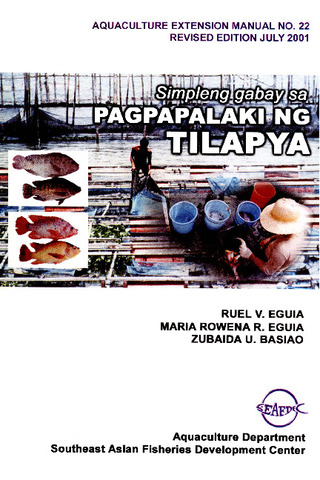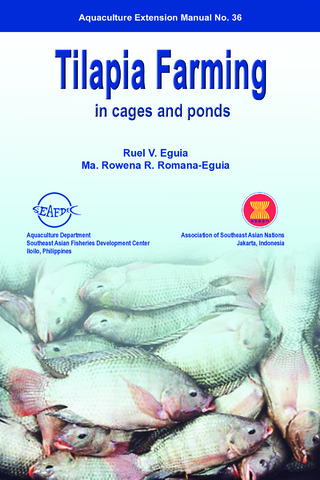Effect of different sizes of saline red tilapia hybrid Oreochromis niloticus Linnaeus x O. mossambicus Peters on the growth of luminous bacteria Vibrio harveyi
| dc.contributor.author | Tendencia, Eleonor | |
| dc.contributor.author | de la Peña, Milagros R. | |
| dc.date.accessioned | 2014-05-29T06:15:31Z | |
| dc.date.available | 2014-05-29T06:15:31Z | |
| dc.date.issued | 2010 | |
| dc.identifier.citation | Tendencia, E. A., & de la Peña, M. R. (2011). Effect of different sizes of saline red tilapia hybrid Oreochromis niloticus Linnaeus x O. mossambicus Peters on the growth of luminous bacteria Vibrio harveyi. The Philippine Agricultural Scientist, 93(4), 463–467. | en |
| dc.identifier.issn | 0031-7454 | |
| dc.identifier.uri | http://hdl.handle.net/10862/2109 | |
| dc.description.abstract | Luminous bacterial disease caused by Vibrio harveyi has devasted the shrimp industry. The use of different strains of tilapia and other fish species polycultured with shrimp cultured at a salinity of 24 ppt to control luminous bacteria has been reported. These species, however, could not tolerate salinities higher than 24 ppt. Alternative species/strains that could be used to control luminous bacteria at high salinities need to be investigated. Likewise, the effect of fish size on the growth of luminous bacteria is worth studying. Shrimp (Penaeus monodon Fabricius) were stocked in concrete tanks filled with 34 ppt cartridge filtered seawater. Tanks were stocked with two sizes (16 pcs, average body weight (ABW) = 55 g and 6 pcs ABW=250 g) of the red tilapia hybrid Oreochromis mossambicus Peters x O. niloticus Linnaeus, except for the tanks that served as the control. Luminous bacteria (V. harveyi) were inoculated into the tank water to a density of 104 Cfu mL-1. Significantly lower luminous bacterial count was observed in tanks with either of the two sizes of red tilapia hybrid compared with the control, after 5-7 d. Bacteria isolated from the fish feces, mucus and rearing water; and the fish feces and mucus themselves demonstrated anti-V. harveyi activity. Results showed that the red tilapia hybrid could be used to control luminous bacteria at salinities as high as 34 ppt and that the size of the fish did not affect its efficiency. The ability of the red tilapia hybrid to control the growth of the luminous bacteria V. harveyi is attributed to different factors such as the mucus, the feces and the bacteria associated with tilapia culture. Bacteria associated with the fish mucus and feces also contributed to the anti-V. harveyi activity of these biological substances. | en |
| dc.language.iso | en | en |
| dc.publisher | College of Agriculture, University of the Philippines Los Baños | en |
| dc.subject | Oreochromis mossambicus | en |
| dc.subject | Oreochromis niloticus | en |
| dc.subject | Penaeus monodon | en |
| dc.subject | Philippines, Panay I., Iloilo | |
| dc.title | Effect of different sizes of saline red tilapia hybrid Oreochromis niloticus Linnaeus x O. mossambicus Peters on the growth of luminous bacteria Vibrio harveyi | en |
| dc.type | Article | en |
| dc.citation.volume | 93 | |
| dc.citation.issue | 4 | |
| dc.citation.spage | 463 | |
| dc.citation.epage | 467 | |
| dc.citation.journalTitle | The Philippine Agricultural Scientist | en |
| dc.subject.asfa | aquaculture | en |
| dc.subject.asfa | bacterial diseases | en |
| dc.subject.asfa | biological control | en |
| dc.subject.asfa | disease control | en |
| dc.subject.asfa | fish culture | en |
| dc.subject.asfa | hybrids | en |
| dc.subject.asfa | immunity | en |
| dc.subject.asfa | laboratory culture | en |
| dc.subject.asfa | luminous organisms | en |
| dc.subject.asfa | polyculture (aquaculture) | en |
| dc.subject.asfa | salinity tolerance | en |
| dc.subject.asfa | shrimp culture | en |
| dc.subject.scientificName | Penaeus monodon | en |
| dc.subject.scientificName | Vibrio harveyi |
このアイテムのファイル
| ファイル | サイズ | フォーマット | 閲覧 |
|---|---|---|---|
|
このアイテムに関連するファイルは存在しません。 |
|||
このアイテムは次のコレクションに所属しています
-
Journal Articles [1256]
These papers were contributed by Department staff to various national and international journals.




